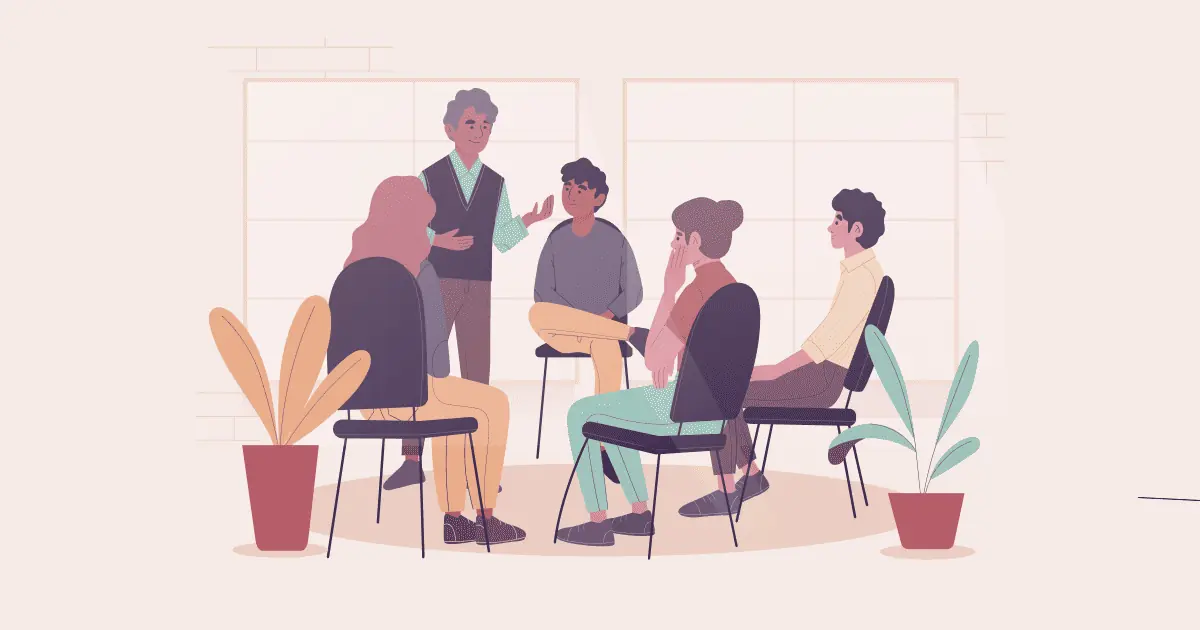Hvad din kropssprog under præsentationen siger om dig? Hvad du bør og ikke bør gøre! Lad os lære de bedste tips med AhaSlides!
Så hvad er den bedste præsentationsstilling? Har du akavede hænder-syndrom? Det har du sikkert ikke, for det har jeg lige fundet på. Men – vi har alle øjeblikke, hvor vi ikke ved, hvad vi skal gøre med vores hænder, ben eller nogen del af vores krop.
Du kan have en fantastisk isbryder, upåklagelig introduktionog fremragende præsentation, men det er leveringen, der betyder mest. Du ved ikke, hvad du skal stille op med dig selv, og det er perfekt normal.
Oversigt
| Hvad er forlegenhedens kropssprog? | nedadgående blik, smilekontrol, vækvendte hovedbevægelser og ansigtsberøring |
| Hvad er de nonverbale tegn på skam? | Sænkede skuldre, sænket hoved, nedadgående blik, ingen øjenkontakt, uregelmæssig tale |
| Kan publikum mærke, hvornår præsentanter er generte? | Ja |
| Hvorfor var Steve Jobs' præsentation så god? | Han øvede sig bare en masse, samtidig med at han testede interesser. præsentationstøj |

Tips til bedre engagement
- Personlighed i en præsentation
- Hvordan udtrykker du dig selv?
- Brug levende ordskyer or live Q&A til undersøg dit publikum lettere!
- Brug brainstorming værktøj effektivt ved AhaSlides idétavle

Start på få sekunder.
Få gratis skabeloner til din næste interaktive præsentation. Tilmeld dig gratis, og tag hvad du vil have fra skabelonbiblioteket!
🚀 Få skabeloner gratis
I hvilken grad ved du, hvad en vellykket præsentation er? Udover veldesignede PowerPoint-skabeloner er det vigtigt at bruge andre præstationsfærdigheder, især kropssprog.
Nu hvor du ved, at kropssprog er en uerstattelig del af præsentationsevner, er det stadig langt fra at mestre disse færdigheder for at levere effektive præsentationer.
Denne artikel giver dig et holistisk overblik over kropssprog og hvordan du kan udnytte disse færdigheder til dine perfekte præsentationer.
Indholdsfortegnelse
- Oversigt
- Tips til bedre engagement
- Kropssprogets betydning under en præsentation
- 10 tips til at mestre kropssprog i præsentationer
- 4 tips til kropsbevægelser
- Ofte stillede spørgsmål
Kropssprogets betydning for præsentationer
I forbindelse med præsentationer af kropssprog, når det kommer til kommunikation, nævner vi verbale og nonverbale termer. Det er afgørende at huske, at disse termer har en relativ relation. Så hvad er det?
Verbal kommunikation er brugen af ord til at dele information med andre mennesker, både talt og skrevet. For eksempel ordet "hvordan går det?", som du vælger for at lade andre forstå, hvad du prøver at hilse på dem.
Nonverbal kommunikation er overførsel af information gennem kropssprog, ansigtsudtryk, gestik, skabt rum og mere. For eksempel udtrykker det venlighed, accept og åbenhed at smile, når man møder nogen.
Uanset om du er bevidst om det eller ej, giver og modtager du konstant ordløse signaler, når du interagerer med andre, udover at tale. Alle dine nonverbale adfærdsmønstre – din kropsholdning, din intonation, de bevægelser, du laver, og hvor meget øjenkontakt du har – formidler vigtige budskaber.
De kan især berolige folk, opbygge tillid og tiltrække opmærksomhed, eller de kan fornærme og forvirre det, du forsøger at udtrykke. Disse budskaber stopper heller ikke, når du holder op med at tale. Selv når du er tavs, kommunikerer du stadig nonverbalt.
På samme måde er en præsentation også en måde at kommunikere med dit publikum på; mens du taler om din idé, så vis kropssprog for at understrege den. Således vil forståelse af vigtigheden af både nonverbale og verbale kommunikationsevner samtidig hjælpe dig med at undgå kedelige præsentationer.
For at gøre det meget mere ligetil udforsker vi elementer af kropssprog, en del af nonverbale kommunikationsevner. Kropssprog omfatter gestus, holdninger og ansigtsudtryk. Når du præsenterer, bliver robust og positivt kropssprog et stærkt instrument til at opbygge troværdighed, udtrykke dine følelser og skabe forbindelse til dine lyttere. Det hjælper også dine lyttere med at koncentrere sig mere om dig og din tale. Her giver vi dig 10+ eksempler på kropssprog og tips til at udnytte din ...
10 tips til at mestre kropssprog i præsentationer
Overvej dit udseende
For det første er det vigtigt at have et pænt udseende under præsentationer. Afhængigt af hvilken lejlighed, skal du muligvis forberede det passende outfit og velplejede hår for at vise din professionalisme og respekt for dine lyttere.
Tænk på arrangementets type og stil; de kan have en streng dresscode. Vælg et outfit, hvor du er meget mere tilbøjelig til at føle dig klar og selvsikker foran et publikum. Undgå farver, tilbehør eller smykker, der kan distrahere publikum, lave støj eller forårsage genskin under scenelys.
Smil, og smil igen
Glem ikke at "smile med dine øjne" i stedet for kun din mund, når du smiler. Det ville hjælpe med at få andre til at føle din varme og oprigtighed. Husk at bevare smilet selv efter et møde – i falske lykkemøder; du kan ofte se et "on-off" smil, der blinker og derefter forsvinder hurtigt, efter at to personer går hver til sit.
Åbn dine håndflader
Når du gestikulerer med hænderne, skal du sørge for at dine hænder er åbne det meste af tiden, så folk kan se dine åbne håndflader. Det er også en god idé at holde håndfladerne vendt opad det meste af tiden i stedet for nedad.
Få øjenkontakt
Det er normalt en dårlig idé at få øjenkontakt med individuelle medlemmer af dit publikum! Det er nødvendigt at finde et sødt sted "længst nok" til at se på dine lyttere uden at være stødende eller uhyggelig. Prøv at se på andre i cirka 2 sekunder for at mindske akavethed og nervøsitet. Se ikke på dine noter for at skabe flere forbindelser med dine lyttere.
Tjek tipsene ud Øjenkontakt i kommunikation
Håndspænde
Du kan finde disse bevægelser nyttige, når du vil afslutte et møde eller afslutte en interaktion med nogen. Hvis du vil fremstå selvsikker, kan du bruge denne cue med tommelfingrene stukket ud - dette signalerer selvtillid i stedet for stress.
Blading
Omkring nære venner og andre, man stoler på, er det dejligt at slappe af med hænderne i lommerne en gang imellem. Men hvis du vil have den anden til at føle sig usikker, er det en sikker måde at stikke hænderne dybt i lommerne på!
rørende øre
Berøring af øret eller en selvberoligende gestus foregår ubevidst, når en person er angst. Men ved du, at det er en god hjælp, når du støder på svære spørgsmål fra publikum? At røre ved dit øre, når du tænker på løsninger, kan gøre din generelle kropsholdning mere naturlig.
Peg ikke med din finger
Uanset hvad du gør, så peg ikke. Bare sørg for aldrig at gøre det. At pege med fingrene, mens man taler, er tabu i mange kulturer, ikke kun i præsentationer. Folk finder det altid aggressivt og ubehageligt, på en eller anden måde stødende.
Styr din stemme
I enhver præsentation skal du tale langsomt og tydeligt. Når du vil understrege hovedpointerne, kan du tale endnu langsommere og gentage dem. Intonation er nødvendig; lad din stemme stige op og ned for at lyde naturlig. Sig nogle gange ingenting i et stykke tid for at få bedre kommunikation.
Går rundt
Det er fint at bevæge sig rundt eller blive på ét sted, når du præsenterer. Men overbrug det ikke; undgå at gå frem og tilbage hele tiden. Gå, når du har til hensigt at engagere publikum, eller mens du fortæller en sjov historie, eller mens publikum griner.
4 tips til kropsbevægelser
I denne artikel vil vi give nogle hurtige tips til kropssprog og hvordan du kan udvikle dine præsentationsevner vedrørende:
- Øjenkontakt
- Hænder og skuldre
- Legacy
- Tilbage og hoved
Dit kropssprog er afgørende, fordi det ikke kun gør dig se mere selvsikker, selvsikker og fattet, men du vil også ende følelse disse ting. Du bør også undgå at se ned, mens du taler.
Øjne – Kropssprog under præsentation
Må ikke Undgå øjenkontakt, som om det var pesten. Mange mennesker ved ikke, hvordan man får øjenkontakt, og de lærer at stirre på bagvæggen eller nogens pande. Folk kan mærke, når du ikke kigger på dem, og de vil opfatte dig som nervøs og fjern. Jeg var en af disse præsentanter, fordi jeg troede, at offentlig tale var det samme som skuespil. Da jeg lavede teaterproduktioner i gymnasiet, opfordrede de os til at se på bagvæggen og ikke engagere os med publikum, fordi det ville tage dem ud af den fantasiverden, vi skabte. Jeg lærte på den hårde måde, at skuespil ikke er det samme som offentlig tale. Der er lignende aspekter, men man ønsker ikke at blokere publikum fra sin præsentation – man vil inkludere dem, så hvorfor skulle man lade som om, de ikke er der?
På den anden side er nogle mennesker lært at se på kun én person, som også er en dårlig vane. At stirre på én person hele tiden vil gøre dem meget ubehagelige, og den atmosfære vil også distrahere de andre publikummer.

DO Få kontakt med folk, som du ville have en normal samtale. Hvordan forventer du, at folk har lyst til at interagere med dig, hvis de ikke føler sig set? En af de mest nyttige præsentationsfærdigheder, jeg har lært af Nicole Dieker er, at folk elsker opmærksomhed! Tag dig tid til at komme i kontakt med dit publikum. Når folk føler, at en oplægsholder bekymrer sig om dem, føler de sig vigtige og opmuntrede til at dele deres følelser. Flyt dit fokus til forskellige publikumsmedlemmer for at fremme et inkluderende miljø. Især engager dig med dem, der allerede ser på dig. Intet er værre end at stirre ned på nogen, der kigger på deres telefon eller program.
Brug så meget øjenkontakt, som du ville gøre, når du taler med en ven. Offentligt talende er det samme, bare i større skala og med flere mennesker.
hænder– Kropssprog under præsentationen
Lad være med at begrænse dig selv eller overtænke det. Der er så mange måder at holde dine hænder forkert på, som bag din ryg (hvilket virker aggressivt og formelt), under dit bælte (begrænser bevægelse) eller stift ved dine sider (hvilket føles akavet). Kryds ikke armene; dette kommer ud som defensivt og udenfor. Vigtigst af alt, lad være med at overbevise! Dette vil ikke kun blive udmattende, men publikum vil begynde at fiksere på, hvor træt du skal være frem for indholdet af din præsentation. Gør din præsentation nem at se og derfor let at forstå.

DO Hvil dine hænder i en neutral position. Dette vil være lidt over din navle. Den mest succesfulde neutrale position er enten at holde den ene hånd i den anden eller blot at røre dem sammen på den måde, dine hænder naturligt ville gøre. Hænder, arme og skuldre er det vigtigste visuelle signal for publikum. Du bør gestus som dit typiske kropssprog i en almindelig samtale. Vær ikke en robot!
Nedenfor er en hurtig video af Steve Bavister, og jeg anbefaler, at du ser den for at visualisere, hvad jeg lige har beskrevet.
Legacy– Kropssprog under præsentationen
Må ikke lås dine ben og stå stille. Ikke alene er det farligt, men det får dig også til at se utilpas ud (gør publikum utilpas). Og ingen kan lide at føle sig utilpas! Blodet vil begynde at samle sig i dine ben, og uden bevægelse vil blodet have svært ved at recirkulere til hjertet. Dette gør dig modtagelig for at besvime, hvilket helt sikkert ville være ... du gættede rigtigt ... ubehagelig. Rør tværtimod ikke for meget i benene. Jeg har været til et par præsentationer, hvor taleren vugger frem og tilbage, frem og tilbage, og jeg var så meget opmærksom på denne distraherende adfærd, at jeg glemte, hvad han talte om!

DO Brug dine ben som en forlængelse af dine håndbevægelser. Tag et skridt fremad, hvis du vil lave et statement, der forbinder dit publikum. Tag et skridt tilbage, hvis du vil give plads til eftertanke efter en forbløffende idé. Der er en balance i det hele. Tænk på scenen som et enkelt plan – du bør ikke vende publikum ryggen. Gå på en måde, der inkluderer alle mennesker i rummet, og bevæg dig rundt, så du kan være synlig fra alle sæder.
Ryg– Kropssprog under præsentationen
Må ikke Fold dig ind i dig selv med hængende skuldre, hængende hoved og buet nakke. Folk har ubevidste bias mod denne form for kropssprog og vil begynde at sætte spørgsmålstegn ved dine evner som præsentator, hvis du fremstår som en defensiv, selvbevidst og usikker taler. Selv hvis du ikke identificerer dig med disse beskrivelser, vil din krop vise det.

DO overbevise dem om din tillid til din holdning. Stå lige som dit hoved er forbundet med en undervist streng fastgjort til loftet. Hvis dit kropssprog skildrer selvtillid, bliver du selvsikker. Du vil blive overrasket over, hvor lidt justeringer vil forbedre eller forværre din taleudlevering. Prøv at bruge disse præsentationsevner i spejlet og se selv!
Til sidst, hvis du har tillid til din præsentation, vil dit kropssprog forbedres drastisk. Din krop vil afspejle, hvor stolt du er af dit visuelle og beredskab. AhaSlides er et fantastisk værktøj at bruge hvis du vil blive en mere selvsikker præsentator og imponere dit publikum med interaktive værktøjer i realtid, som de kan få adgang til, mens du præsenterer. Det bedste? Det er gratis!
Konklusion
Så hvad siger kropssprog under præsentationen om dig? Lad os benytte os af vores tips og overveje, hvordan du kan integrere dem i din præsentation. Tøv ikke med at øve dig foran spejlet derhjemme eller med et velkendt publikum og bede om feedback. Øv dig gør mester. Du vil være i stand til at mestre dit kropssprog og få positive resultater ud af din præsentation.
Ekstra tipVed en virtuel onlinepræsentation eller når du bærer en maske, kan du støde på vanskeligheder med at vise kropssprog. Du kan overveje at bruge din præsentationsskabelon til at fange publikums opmærksomhed med 100+ AhaSlides-typer af præsentationsskabeloner.
Ofte stillede spørgsmål
Hvad skal man gøre med sine hænder, når man præsenterer
Når du præsenterer, er det vigtigt at bruge dine hænder målrettet for at give et positivt indtryk og forstærke dit budskab. Derfor bør du holde dine hænder afslappede med åbne håndflader, bruge fagter, der gavner din præsentation, og opretholde øjenkontakt med dit publikum.
Når jeg præsenterer for et neutralt publikum, hvorfor skal jeg så præsentere begge sider af sagen?
Det er vigtigt at præsentere begge sider af en sag for et neutralt publikum, da det hjælper dig med at engagere dig med publikum, styrker din kritiske tænkning, gør din præsentation bedre og hjælper også med at øge troværdigheden.
Hvilken type gestus skal undgås i en tale?
Du bør undgå distraktionsbevægelser, såsom: at tale dramatisk, men ikke relevant for dit indhold; tumle som at banke på fingrene eller lege med genstande; pegende fingre (som viser manglende respekt); krydsende arme og overraskende og alt for formelle fagter!






